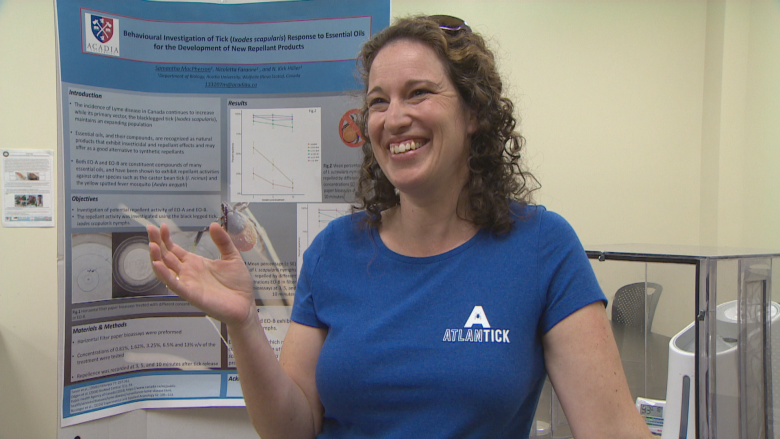Citizen scientist's all-natural spray sends ticks running in first tests
A natural anti-tick spray created by a Mahone Bay, N.S., woman has yielded some encouraging results from its first round of scientific tests at Acadia University.
Lisa Ali created AtlanTick after her two sons developed Lyme disease from ticks on the South Shore in 2016. She said the ticks were so small that they didn't see them.
She wanted a tick repellent that wasn't chemically based, so she created her own with a mix of water, witch hazel, jojoba oil and other essential oils. But does it work?
Enter Nicoletta Faraone, a scientist at Acadia University's department of biology. With financial help from the Nova Scotia Productivity and Innovation voucher and a National Research Council grant, she created a tick habitat and put the ticks on a dish with three circles. If they left the inner circle, that would mean AtlanTick wouldn't have worked.
But most turned back as soon as they hit the spray.
"The results are pretty interesting because the AtlanTick body spray repelled about 75, 80 per cent of the tested ticks," Faraone said. "These results were compared to DEET, which recorded 100 per cent of repellency. It's pretty encouraging, because we clearly saw a repellency effect."
Ali can't hide her smile as the ticks turn back. She had done a lot of research and wasn't surprised her spray was working.
"Now I know for sure that the oils I mix together actually work and for people who do think of essential oils as kind of new-agish, this is a great way to show them that it does work."
Ali is working to get Health Canada approval to sell the product as a tick spray, though that will likely take another two years of tests. Faraone said they will test variations of the product in different situations.
"For now we have data up to 10 minutes, so we want to see after one hour, after two hours and so on, and also we want to test on the skin to see if the tick is repelled or drops off."
Lyme disease is a bacterial infection, the result of a bite from an infected blacklegged tick. According to Health Canada, symptoms may resemble those of the flu including fever, chills, headache, fatigue, muscle and joint aches, and a rash that's sometimes shaped like a bull's eye.
The government of Nova Scotia says only blacklegged ticks (not all of them) carry that bacteria.
In Nova Scotia alone, 1,020 cases of Lyme disease were reported between 2002 and 2016, and tick populations are growing in the province.
Dr. Robert Strang, chief medical officer of health, said the province recommends using DEET.
"We don't have any information on this product to comment on its effectiveness," said his spokesperson, Tracy Barron.
Here are some tips to reduce risks of disease from ticks:
- In addition to using repellents, wear light-coloured, long-sleeved clothing and tuck pant legs into socks.
- The government recommends checking yourself, pets and children for tick after walking in grassy or wooded areas.
- If you find a tick, use tweezers to pull it straight out.




